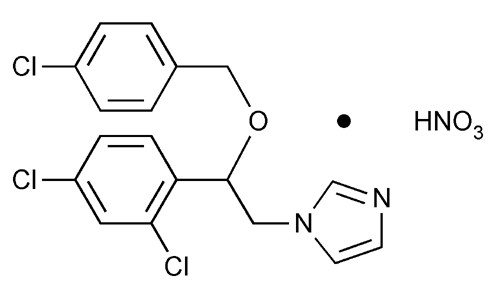Econazole Nitrate
1H-Imidazole, 1-[2-[(4-chlorophenyl)methoxy-]2-(2,4-dichlorophenyl)[ethyl]-, mononitrate, (±)-.
(±)-1-[2,4-Dichloro-
» Econazole Nitrate contains not less than 98.5 percent and not more than 101.0 percent of C18H15Cl3N2O·HNO3, calculated on the dried basis.
Packaging and storage—
Preserve in well-closed containers, protected from light.
Identification—
Solution:
800 µg per mL.
Medium:
0.1 N hydrochloric acid in methanol (1 in 10).
C:
Shake 10 mg with 5 mL of water, and cool the resulting suspension in ice. Keeping the suspension cool, add 0.4 mL of potassium chloride solution (1 in 10), 0.1 mL of diphenylamine TS, and dropwise, with shaking, 5 mL of sulfuric acid: an intense blue color develops.
Loss on drying  731
731 —
Dry it at 105
—
Dry it at 105 to constant weight: it loses not more than 0.5% of its weight.
to constant weight: it loses not more than 0.5% of its weight.
Residue on ignition  281
281 :
not more than 0.1%.
:
not more than 0.1%.
Chromatographic purity—
Standard preparation—
Dissolve an accurately weighed quantity of USP Econazole Nitrate RS in methanol to obtain a solution containing 75 µg per mL.
Test preparation—
Dissolve an accurately weighed quantity of Econazole Nitrate in methanol to obtain a solution containing 20 mg per mL.
Procedure—
Apply separately 20 µL of the Test preparation and 20 µL of the Standard preparation to a suitable thin-layer chromatographic plate (see Chromatography  621
621 ) coated with a 0.25-mm layer of chromatographic silica gel. Allow the spots to dry, place the plate in a chromatographic chamber, and develop the chromatograms in a solvent system consisting of a mixture of 1,4-dioxane, toluene, and 13.5 M ammonium hydroxide (60:40:1) until the solvent front has moved about three-fourths of the length of the plate. Remove the plate from the developing chamber, mark the solvent front, and dry the plate in a current of air. Expose the plate to iodine vapors for 1 hour, and air-dry until the iodine has dissipated. Compare the intensities of any secondary spots observed in the chromatogram of the Test preparation with that of the principal spot in the chromatogram of the Standard preparation: no individual secondary spots in the chromatogram of the Test preparation are larger or more intense than the principal spot produced by the Standard preparation, corresponding to not more than 0.375%, and the total of all such secondary spots observed is not more than 2.0%.
) coated with a 0.25-mm layer of chromatographic silica gel. Allow the spots to dry, place the plate in a chromatographic chamber, and develop the chromatograms in a solvent system consisting of a mixture of 1,4-dioxane, toluene, and 13.5 M ammonium hydroxide (60:40:1) until the solvent front has moved about three-fourths of the length of the plate. Remove the plate from the developing chamber, mark the solvent front, and dry the plate in a current of air. Expose the plate to iodine vapors for 1 hour, and air-dry until the iodine has dissipated. Compare the intensities of any secondary spots observed in the chromatogram of the Test preparation with that of the principal spot in the chromatogram of the Standard preparation: no individual secondary spots in the chromatogram of the Test preparation are larger or more intense than the principal spot produced by the Standard preparation, corresponding to not more than 0.375%, and the total of all such secondary spots observed is not more than 2.0%.
Assay—
Dissolve about 400 mg of Econazole Nitrate, accurately weighed, in 50 mL of glacial acetic acid, and titrate with 0.1 N perchloric acid VS, determining the endpoint potentiometrically, using a glass-calomel electrode system (see Titrimetry  541
541 ). Perform a blank determination, and make any necessary correction. Each mL of 0.1 N perchloric acid is equivalent to 44.47 mg of C18H15Cl3N2O·HNO3.
). Perform a blank determination, and make any necessary correction. Each mL of 0.1 N perchloric acid is equivalent to 44.47 mg of C18H15Cl3N2O·HNO3.
Auxiliary Information—
Please check for your question in the FAQs before contacting USP.
| Topic/Question | Contact | Expert Committee |
| Monograph | Behnam Davani, Ph.D., M.B.A.
Senior Scientist 1-301-816-8394 |
(MDAA05) Monograph Development-Antivirals and Antimicrobials |
| Reference Standards | Lili Wang, Technical Services Scientist 1-301-816-8129 RSTech@usp.org |
USP32–NF27 Page 2228
